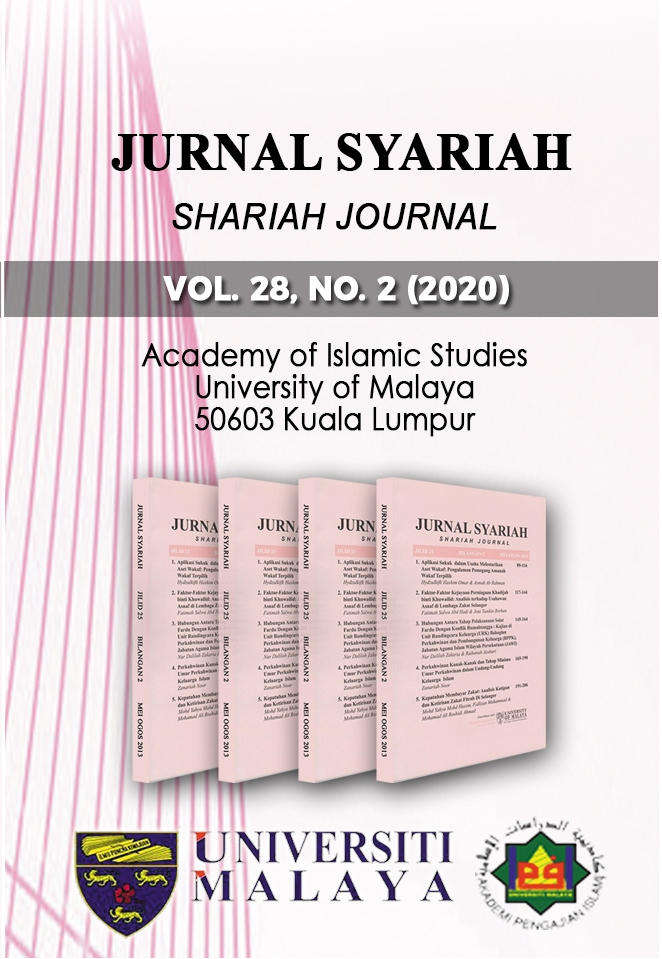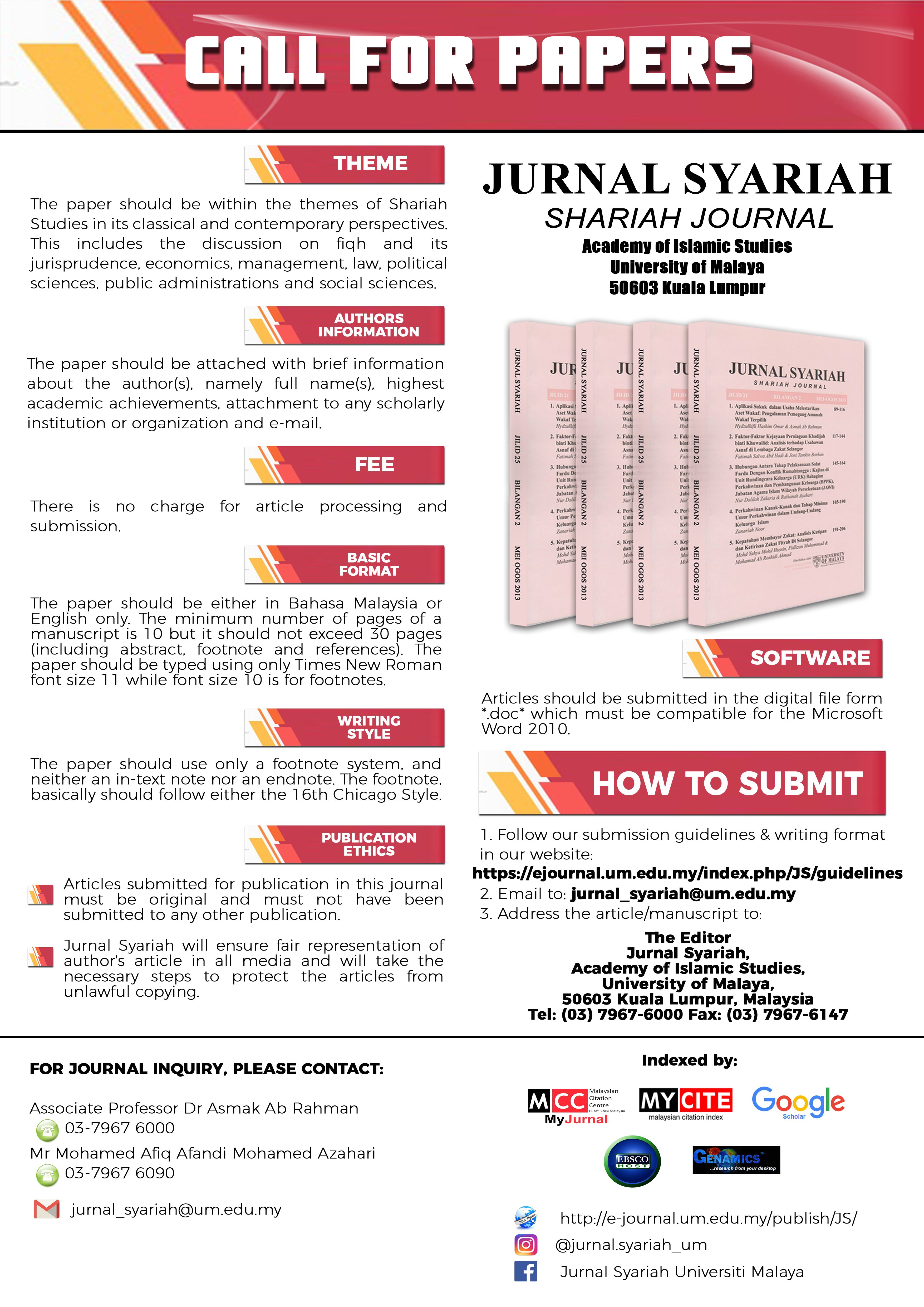THE TUNISIAN CONSTITUTIONAL TRANSITION AND DEBATES: ISLAM, WOMEN AND OTHER ACTORS IN THE WAKE OF THE POST JASMINE REVOLUTION
DOI:
https://doi.org/10.22452/js.vol28no2.5Keywords:
Jasmine revolution, Islam, women, constitution, debatesAbstract
The Arab uprising in Tunisia, dubbed the Jasmine Revolution began in 2010, protesting against unemployment, corruption, injustice and the absence of basic freedoms. The Jasmine Revolution ousted Ben Ali, the then president who was in power for more than three decades in 2011. Post Jasmine Revolution saw Tunisia making commendable strides in its transition towards a new all-inclusive democratic political order. However, the transition process has not been without obstacles which could have had the effect of derailing the transition process, such as the assassination of activists Chokri Belaïd and Mohamed Brami, the role and place of Islam, the inclusion of women in the political transition and the most popular Islamic party Ennahda with its rumours of transforming Tunisia into an Islamic state were cause for great concern for all. However, despite these concerns, Tunisia’s new constitutional text is considered to be a radical departure from its previous constitutional texts. After the drafting of various drafts, the 2014 constitutional text has attained the status in the Middle Eastern And North African Region MENA Region as being the most liberal compared to other countries in the Mena Region. The 2014 constitutional provisions protect civil liberties, separates legislative, executive and judicial powers, guaranteeing women parity in political institutions, and declares that Islam is the country’s official religion while at the same time protecting religious freedom for all. An important facet is the homogeneity of Tunisian society – which although has some divisions, did not suffer fragmentation along religious, political, cultural or ethnic lines, as is the case in other Muslim states. This was accomplished by including all actors not only political parties, women’s groups and activists, religious activists, but also the various unions which represented the working class in Tunisia. The outcome was nothing short of being miraculous, bearing in mind the chaos that engulfed Tunisia during this period. One could argue that Tunisian listened to its people and advice of all, thereby minimising a terrible outcome.
Downloads
References
Albertyn, ‘Towards Substantive Representation: Women and Politics in South Africa,’ in Women Making Constitutions: New Politics and Comparative Perspectives, ed. Alexandra D & Hart V (London: Palgrave Macmillan, 2003), 99-117.
Al-Sharmani, Recent Reforms in Personal Status Laws and Women’s Empowerment: Family Courts in Egypt (Egypt: The American University in Cairo Social Research Center, 2007).
Angrist, ‘The Expressions of Political Dissent in the Middle East: Turkish Democratization and Authoritarian Community in Tunisia,’ Comparative Studies in Society and History, vol. 41, no. 4 (1999): 730-757.
Arieff, ‘Political Transition in Tunisia Congressional Research Service Report for Congress,’ http://www.refwold.org, accessed on 14 October 2018.
Aswad, ‘The Role of Religion in Constitutions Emerging from Arab Spring Revolutions,’ Georgetown Journal of International Affairs, vol. 16, no. 1 (2015): 159-169.
BBC News, ‘The Tunisian President Fouad Mebazza Calls Election,’ http://www.bbc.co.uk/news/world-middle-east, accessed on 10 October 2018.
Böckenförde, ‘The Dynamics of Comprehensive Constitution-building: Religion and the Concept of Twin Tolerations in Tunisia,’ The Tunisian Constitutional Process: Main Actors and Key Issues, ed. Mathieu Rousselin & Christopher Smith (Duisberg: Käte Hamburger Kolleg / Centre for Global Cooperation Research, 2015), 24-35.
Boulby, ‘The Islamic Challenge: Tunisia since Independence,’ Third World Quaterly, vol. 10, no. 2 (1998): 590.
Bousbih & Yaalaoui, ‘The Interplay of Politics and Religion in the New Tunisian Constitution: A Legal Analysis,’ in The Tunisian Constitutional Process: Main Actors and Key Issues (Duisburg, Germany: Global Dialogues, 2015), 16-23.
Brandt, ‘Constitutional-Making and Reforms: Options for the Process,’ http://constitutionalmakingforpeace.org, accessed on 19 October 2018.
Charfi, Islam and Liberty: The Historical Misunderstanding (London: Zed Books, 2005).
Charrad MM, ‘Policy Shifts: State, Islam, and Gender in Tunisia, 1930s-1990s,’ Social Politics (1997): 284-319.
Charrad, ‘Tunisia at the Forefront of the Arab World: Two Waves of Gender Legislation,’ Washington and Lee Law Review, vol. 64, no. 4 (2007): 1513.
Chusanayaini, ‘Dynamics of Tunisian Polygamy Law in Gender Perspective,’ media.netli.com, accessed on 2 May 2020.
Croitoru, ‘Controversy Surrounding the Al-Zaytuna in Tunis: The Ambivalent Revival of Islamic Traditions,’ http://en.qatana.de, accessed on 17 January 2019.
David “The Dark Ages of Islam: Ijtihad, Apostacy, and Human Rights in Contemporary Islamic Jurisprudence” Washington and Lee Journal of Civil Rights and Social Justice (2003)
De Silva de Alwis, Mnasri & Ward, ‘Women and the Making of the Tunisian Constitution,’ http://acholarship.law.upenn.edu, accessed on 19 October 2017.
Dewey, Kaden, Marks, Matsushima & Zhu, ‘The Impact of Social Media on Social Unrest in the Arab Spring,’ http://www.publicpolicystanford., accessed on 5 January 2019.
El-Sayed, ‘Post-Revolution Constitutionalism: the Impact of Drafting Process on the Constitutional Documents in Tunisia and Egypt,’ Electronic Journal of Islamic and Middle Eastern Law, vol. 2 (2014): 39-62.
Entilis, ‘Reformist Ideaology in the Arab World: The Case of Tunisia and Lebanon,’ The Review of Politics, vol. 37, no. 4 (1975): 513-546.
Feuer, ‘Islam and Democracy in Practice: Tunisia’s Ennahda Nine Months,’ http://brandeis.edu, accessed on 20 October 2018.
Geneva International Centre for Justice, ‘Tunisia’s UPR-2017 (conferences-meetings/upr-sessions/ 1070-tunisia-s-upr-2017),’ http://www.gicj.org/oppositions-opinions, accessed on 19 October 2018.
Guellali, ‘The Constitution-Making Process in Tunisia,’ The Carter Center, http://www.cartercenter.org, accessed on 30 October 2018.
Habous Encyclopedia.com, http://www.encyclopedia.com, accessed on 5 January 2019.
Hourani, A History of the Arab Peoples (United Kingdom: Farber & Farber, 2013).
Karray, ‘The National Constituent Assembly, Historical Lessons and Contemporary Stakes,’ Right to Nonviolence Tunisia Constitutional E-Forum, http://www.rightononviolence.org/mecf/mr-bassem-karray, accessed on 19 October 2018.
Khalfoune T Le Domaine Public Et Le Trust (2005) Revue internationale de droit comparé, vol. 57 no. 2 (2005): 441-470.
Khalil, ‘Tunisia’s Women: Partners in Revolution,’ Journal of North African Studies, vol. 19, no. 2 (2014): 186-199.
Majalla’s Notes, ‘Islamism in the Maghreb: Taming Islamists by Integrating Them Into the Political System,’ http://facebook.com, accessed on 26 September 2018.
Marsad, http://www.marsad.tn/fr/, accessed on 3 October 2018.
Mashour, ‘Islamic Law and Gender Equality: Could There Be A Common Ground?: A Study of Divorce and Polygamy in Sharia Law and Gender Equality,’ Human Rights Quarterly, vol. 27, no. 2 (2005): 562-596.
Micaud, ‘Tunisia’s Foreign Policy: Independence and Development,’ Africa Today: African Non-Alignment and Foreign Policies, vol. 15, no. 6 (1968-1969) 12-15.
Morse & Sayeh, ‘Tunisia: Marriage, Divorce, and Foreign Recognition,’ Family Law Quarterly, vol. 29, no. 3 (1995): 39-62.
Murphy, ‘Constitutional Rights Discourse: Canadian and South African Feminist Engagements,’ in Women Making Constitutions: New Politics and Comparative Perspectives, ed. Alexandra D & Hart V (London: Palgrave Macmillan, 2003), 1-218.
Nouira, ‘Obstacles on the Path of Tunisia’s Democratic Transformation,’ Carnegie Endowment for International Peace, http://carnegieendowment.org, accessed on 12 October 2018.
Office of the United Nations High Commissioner for Human Rights (OHCHR), ‘Report of the OHCHR Assessment Mission to Tunisia 26 January 2011 to 2 February 2011,’ http://www.ohchr.org/encountries/menaregions, accessed on 19 October 2018.
Omri, ‘The Status of Women under Tunisian Law,’ Journal of Policy Studies, vol. 18 (2004): 147-161.
Proctor & Moussa, ‘The Tunisian Constituent Assembly’s By-laws: A Brief Analysis,’ http://www.ndi.org, accessed on 30 September 2018.
Rehman “The Sharia, Islamic Family Laws and International Human Rights Law: Examining The Theory And Practice of Polygamy and Talaaq” International Journal of Law, Policy and the Family” (2007)
Salem, ‘Tunisia,’ www.freedomhouse.org, accessed on 3 January 2019.
Schäfer, ‘The Tunisian Transition: Torn Between Democratic Consolidation and Neo-Conservatism in an Insecure Regional Context,’ European Institute of the Mediterranean, http://www.die-gdi.ide, accessed on 19 October 2018.
Shaqoura & Kristiansen, ‘Islam and Human Rights: The Constitutional Debate in Tunisia,’ The Danish Institute for Human Rights, http:// www.humanrights.dk, accessed on 16 October 2018.
Shults, ‘Tunisia: Democracy and Islam in post-Arab Spring Politics,’ http://scholar.utc.edu/honors-thesis, accessed on 13 October 2018.
Stepan, ‘Tunisia’s Transition and the Twin Tolerations,’ Journal of Democracy (2012): 89-103.
Suliman, ‘The First Political Systems in the Independent Maghrib: A Comparative Study,’ http://www.iua.edu.sd, accessed on 20 September 2018.
Tais, ‘Islamic Perspectives in Post-revolutionary Tunisia,’ Journal of Religion & Society, vol. 17 (2015): 1-12.
Tamaru, Holt-Ivry & O’Reilly, ‘Beyond Revolution: How Women Influenced Constitution Making in Tunisia,’ http:// www.inclusivesecurity.org, accessed on 19 October 2018.
The Carter Center, ‘The Carter Congratulates Tunisia’s National Constituent Assembly on Final Draft of Constitution and Urges Safeguards for Human Rights,’ http://cartercenter.org, accessed on 2 October 2018.
The Role of Islamic Law in Tunisia’s Constitution and Legislation, http://www.loc.gov/law/help/tunisia.php, accessed on 9 October 2018.
Venice Commission, ‘Blasphemy, Insult and Hatred: Finding Answers in a Democratic Society,’ Science and Technique of Democracy Series, no. 47 (Strasbourg: Council of Europe, 2010).
Warren, ‘Lifting The Veil: Women and Islamic Law,’ Cordoza Journal of Law & Gender (2008): 1-33.
Zeghal, ‘The Implicit Sharia: Established Religion and Varieties of Secularism in Tunisia,’ in Varieties of Religious Establishment, ed. Winnifred Fallers Sullivan & Lori G. Beaman (London: Ashgate, 2013), 107-130.
Zoglin, ‘Tunisia at a Crossroads: Drafting a New Constitution,’ American Society of International Law, vol. 17, no. 18 (2013), 1-19.
Constitutions
Constitution of Malta 1964
Constitution of Tunisia 2014
Constitution of Tunisia 1959
Constitution of Tunisia 1861
Pacte de Fondamental 1856
International Statutes
Roman Catholic Relief Act of 1829
Jews Relief Act of 1858
The Tunisia Code of Personal Status of 1956
The Venice Commission of 2020
United Nations Human Rights Office of The High Commission
Universal Declaration of Human Rights, GA Res 217A (III), GOAR 3rd Session, Resolutions, (Part 1) UN Doc A/810, adopted 10 December 1948.
International Covenant on Civil and Political Rights, GA Res 2200 (XXI), UN GAOR 21st Session, Supp No 16, UN Doc A/6316 (1996) UNTS 171, adopted 16 December 1966.
Case Law
A. I v. Turkey 2005 (42571/98) European Court of Human Rights, http://hudoc.echr.coe.int, accessed on 27 October 2018.
Downloads
Published
How to Cite
Issue
Section
License

This work is licensed under a Creative Commons Attribution-NonCommercial 4.0 International License.
COPYRIGHT: All rights reserved. Not allowed to be reproduced any part of articles and contents of this journal in any form or by any way, whether electronic, mechanical, photocopying, recording or otherwise without permission in writing from the Chief Editor, Jurnal Syariah.



















